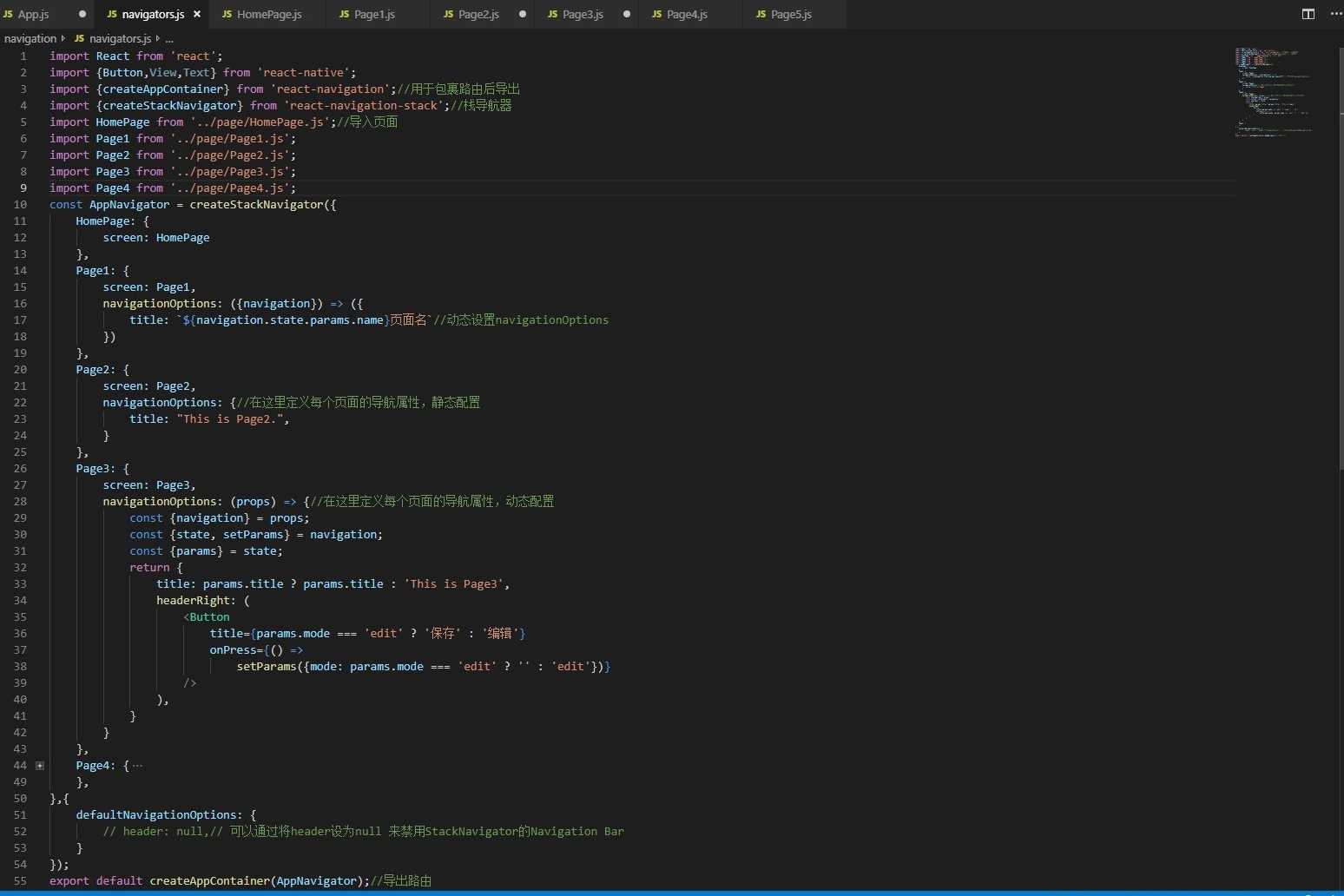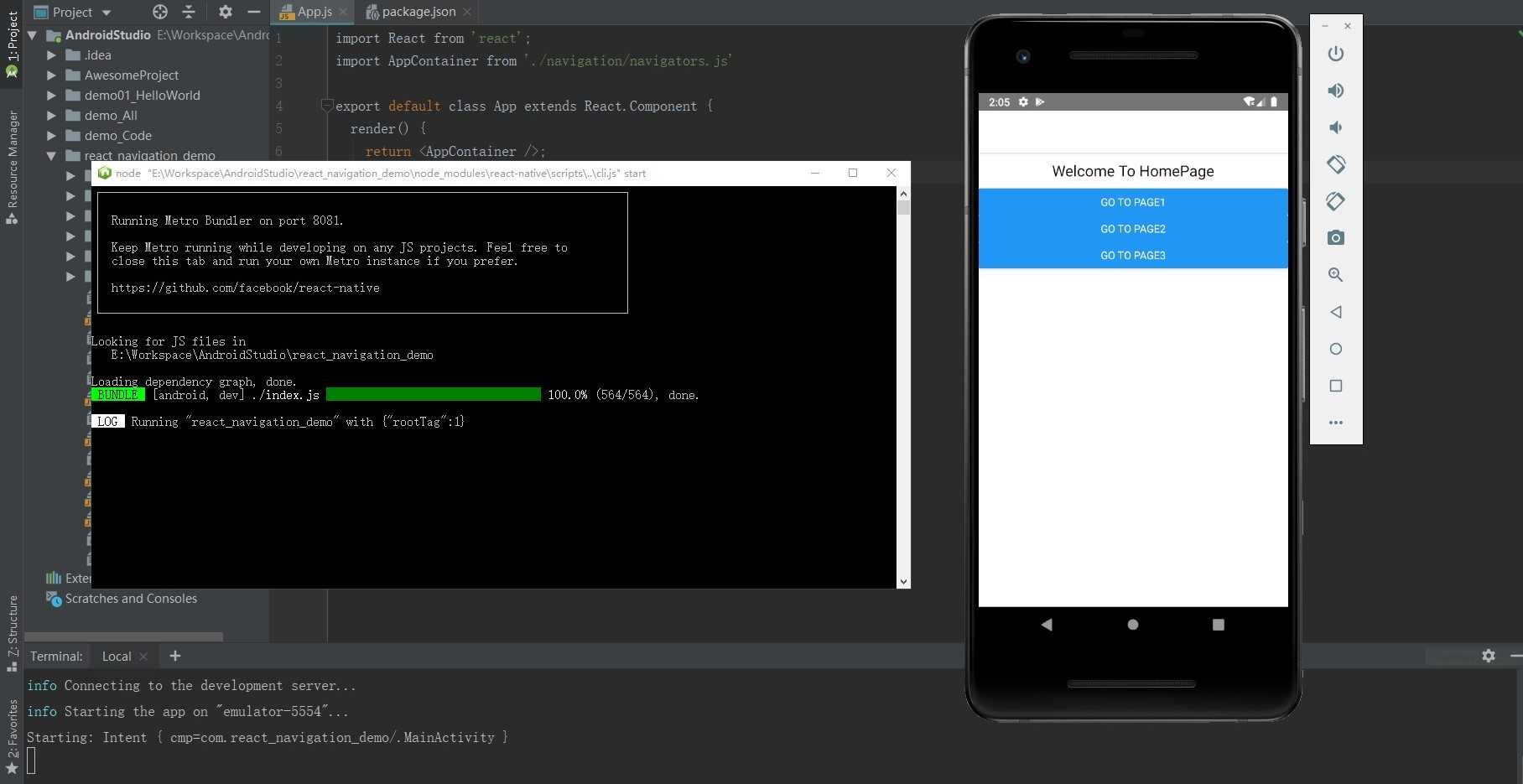前言:官方文档已经看了一遍,但印象不是很深,于是在mooc上找了个实战学习项目做一做。
本篇目录:
1.ReactNavigation之createStackNavigator导航器案例练习
相关资料:
练习链接:http://www.devio.org/2018/12/24/createStackNavigator/
React Navigationan官网:https://reactnavigation.org/docs/zh-Hans/getting-started.html
1. 初始化react native项目
react-native init react_navigation_demo
2. 在项目目录下安装reactnavigation这个包
yarn add react-navigation
3. 安装依赖
yarn add react-native-reanimated react-native-gesture-handler react-native-screens@^1.0.0-alpha.23
4. 为了完成 react-native-screens 在 Android 上的安装, 请在android/app/build.gradle 中 dependencies 选项中添加下面这两行:
implementation ‘androidx.appcompat:appcompat:1.1.0-rc01‘
Implementation ‘androidx.swiperefreshlayout:swiperefreshlayout:1.1.0-alpha02‘
5. 新建并配置路由文件navigator/navigators.js

6. 新建页面文件夹Page,构建HomePage.js,Page1.js,Page2.js,Page3.js,Page4.js,Page5.js等页面
HomePage.js
import React,{Component} from ‘react‘;
import {Button ,View,Text,StyleSheet} from ‘react-native‘;
export default class HomePage extends Component{
render(){
const {navigation}=this.props; //获取navigation
return(
<View style={styles.container}>
<Text style={styles.welcome}>Welcome To HomePage</Text>
<Button title={‘Go to Page1‘} onPress={()=>{
navigation.navigate(‘Page1‘,{name:‘动态的‘});//跳转页面,并且允许传递参数
}} />
<Button title={‘Go to Page2‘} onPress={()=>{
navigation.navigate(‘Page2‘);
}} />
<Button title={‘Go to Page3‘} onPress={()=>{
navigation.navigate(‘Page3‘,{name:‘动态的‘});
}} />
</View>
)
}
}
const styles=StyleSheet.create({
container:{
flex:1,
},
welcome:{
fontSize:20,
textAlign:‘center‘,
margin:10,
}
});
Page1.js
import React from ‘react‘; import {Button,View,Text,StyleSheet} from ‘react-native‘; export default class Page1 extends React.Component{ render(){ const {navigation}=this.props; return( <View style={styles.container}> <Text style={styles.welcome}>Welcome To Page1</Text> <Button title={‘Go Back‘} onPress={()=>{ navigation.goBack(); }} /> <Button title={‘Go TO Page4‘} onPress={()=>{ navigation.navigate(‘Page4‘); }} /> </View> ) } } const styles=StyleSheet.create({ container:{ flex:1, }, welcome:{ fontSize:20, textAlign:‘center‘, margin:10, } });
Page2.js
import React from ‘react‘; import {View,Text,StyleSheet} from ‘react-native‘; export default class Page2 extends React.Component{ render(){ const {navigation}=this.props; return( <View style={styles.container}> <Text style={styles.welcome}>Welcome To Page2</Text> </View> ) } } const styles=StyleSheet.create({ container:{ flex:1, }, welcome:{ fontSize:20, textAlign:‘center‘, margin:10, } });
7. 修改根目录下的APP.js,将路由导入
import React from ‘react‘; import AppContainer from ‘./navigation/navigators.js‘//导入路由文件 export default class App extends React.Component { render() { return <AppContainer />; } }
8. 启动连接虚拟手机,用react-native run-android编译运行代码

原文:https://www.cnblogs.com/zlforever-young/p/11723863.html